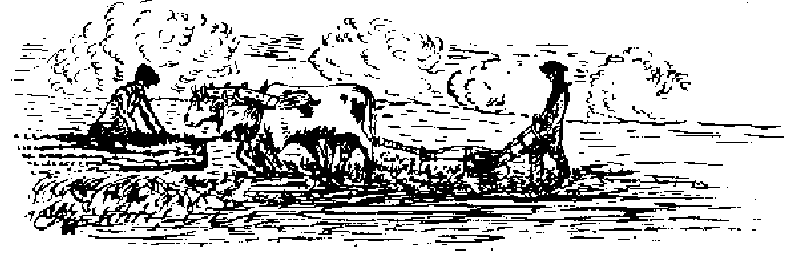Prairie Mothers whose graves dot the western prairies after a life which was shadowed by more grief and worry than joy?
May they rest in the peace they so richly deserve.
WHAT THE PIONEERS LIVED ON
It was a meager fare those first settlers had in the early days of the settlement of the prairies fare that few people in any land have had to endure, and, to the descendants of these people, the food that their forebears had to live on will be of interest.
For the first meal of the day, there was bread when they had it; syrup or sorghum when they had it, and coffee when they had it. When these items were not available there was corn meal from the short flint corn. During the winter of 1877, the last of the "grasshopper" years, the settlement was close to starvation. Most of the cattle had been killed for food and the settlers existed mostly on corn meal that was sent out by the State.
For the midday meal there was boiled fish and boiled potatoes and what few vegetables were saved from the grasshoppers. Navy beans were not grown by the settlers but most of them had a patch of field peas and the peas made good filling material.
Supper was a combination of the above food. There were no pumpkin pies nor any other kinds of pies, no sauce and no preserves. Many homes were compelled to go without cake, pies or cookies for years.
The old milk cow, when it was giving milk, was the foundation of the filled stomach. From her they got milk, cream, butter, cheese, and when a critter broke its leg, there was beef to eat. Cattle were not plentiful. Many of the settlers had only one cow when they came, and when that cow was not giving milk, conditions were really serious. One pioneer told us that they had bought two pounds of butter at six cents a pound from a neighbor, but it was so strong they could not eat it and they were out twelve cents—a lot of money to throw away in those days. No wonder the butter was rancid; a family of eight people was cooped up in a twelve by sixteen sod house, eating,
— 30—
living, sleeping and doing all the housework. Ventilation was unknown. Every bit of heat was conserved during the winter months.
The tea that we know was unknown to the settlers. They did, however, pick the leaves from a weed known as "wild tea" and brewed it. It was not tea but it helped.
There was no lard to cook with the first two or three years. It seems strange, but remember they were two weeks and some times more on the trail from Fillmore County. Carrying a crate of pigs alongside the covered wagon was unthinkable. Some of the settlers brought salt pork with them and from that supply they were able to get a little fat to cook with and a little lard for the lamps.
There were very few chickens. They had to be brought in small pens attached to the side of the covered wagons and naturally it took some time before the settlers were able to get enough eggs or a chicken to eat.
Breaking Up the Raw Prairie

A sketch of the early settlers turning over the prairie so that a crop of grain
could be raised the next year
When the soil had been prepared, there were always plenty of vegetables. They all grew splendidly in the new breaking. Even in the grasshopper days, those dark days that tried the souls of men and women, the settlers were able to save some vegetables. The women took their dresses, nightgowns and everything else they had, including petticoats, to spread on the vegetables to keep off the ravenous grasshoppers.
—31—
Previous Page
Next Page
Table of Contents
Index of Names
Home

